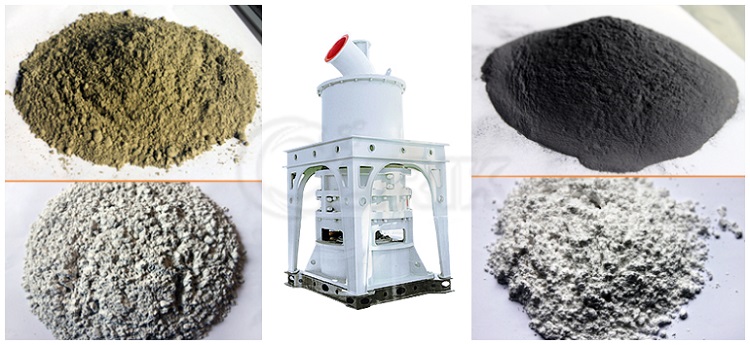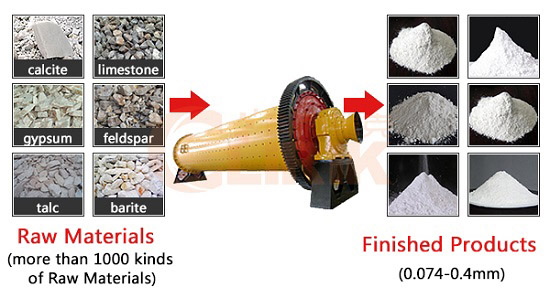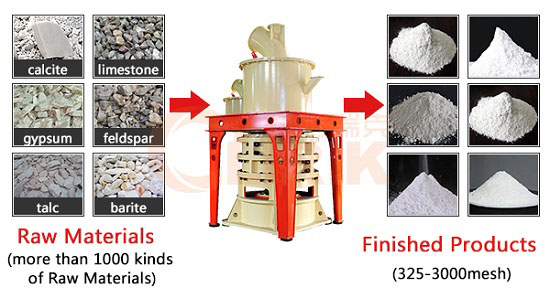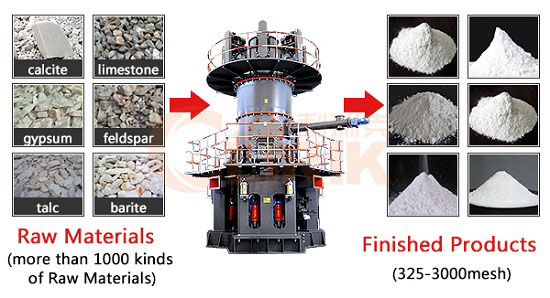Grinding industry common abrasives are barite, quartz, feldspar, mica, calcite, talc, apatite, gypsum, fluorite, limestone, dolomite, diatomite, ceramic soil, clay, marble, granite, fly ash, kaolin, calcium carbonate, slag, bauxite, glass and so on. Choosing the right grinding mill is also a very important link, these materials should be selected according to the requirements of different fineness of different grinding mill to determine the final product required particle size, different grinding mill has different capabilities to reduce the particle size.  Introduce to the millGrinding mill is a kind of production equipment, its models are diverse, can complete different materials of different grinding needs, processing of different quality of finished products can be used in the production of different industries, a brief introduction.
Introduce to the millGrinding mill is a kind of production equipment, its models are diverse, can complete different materials of different grinding needs, processing of different quality of finished products can be used in the production of different industries, a brief introduction.
We know that the mineral mill is used to grind materials, can process more types of materials, so it has a wide range of applications, in general, according to the size of the finished particle, the machine can be divided into three types, They are ultrafine grinding equipment (finished size 425-3250 mesh), fine grinding equipment (finished size 80-425 mesh), coarse grinding equipment (finished size 0-5 mm), these three different types of grinding equipment, can process more types of materials in production, Common fly ash, phosphogypsum, desulphurized gypsum, construction waste, pulverized coal, water slag, bentonite, gypsum, etc., these different types of materials can be used in the production of different industries after the processing of mineral powder mill.
In terms of the application range of grinding equipment itself, it is mostly seen in construction, mining, ore, power plant, chemical industry, metallurgy, cement, roads, building materials, mineral processing, sand and gravel plants, dry powder mortar, refractory materials, in the production of these industries, the choice of mineral grinding machine is mainly carried out according to the production needs. Only by choosing the right grinding equipment can we meet the needs of production.
Type of the mill
There are many types of grinding machines: Raymond mill, ultrafine mill, coarse hammer mill, ring roller mill, ball mill, etc., but according to their requirements for different fineness, the choice of mill is crucial.
For finer particle sizes, you may need a grinder with higher grinding efficiency, such as a ball mill or a stirring media mill. If a coarser particle size is acceptable, a roller mill or a hammer mill is more suitable for your choice.
If you need to process rough materials, such as cement, silicate products, new building materials, refractories, fertilizers, etc., it is recommended that you use a ball mill, its fineness of powder is about 20 ~ 200 mesh.
Capacity: 20-200t/h
Max feeding size: 25mm
Processing ability: 20-200t/hThe ball mill is the key equipment for grinding after crushing, which can be used for dry grinding and wet grinding of various ores and other abrasive materials.
About the Characteristics of the Ball Mill:
- Using large diameter double row spherical roller bearing, reduce friction, reduce the energy consumption of 20-30%.
- End cover structure, large caliber inlet and outlet, the processing capacity is increased by 15-20%.
- simple structure, split installation.
- without inertial impact, the equipment runs smoothly, and reduces the downtime of the mill shutdown and improves efficiency by 15-25%.
 If you want to process fine powder, I recommend our company Raymond mill.
Capacity: 0.2-50 t/h
If you want to process fine powder, I recommend our company Raymond mill.
Capacity: 0.2-50 t/h
Max feeding size: 35mm
Processing ability: 0.2-50 t/h
Advantages of Raymond Mill:
- Vertical structure, small footprint, solid system.
2.As a classic mill in the grinding industry, it can meet the needs of most industries.
3.Adjustable particle size :80-325 mesh.
4.Raymond mill main transmission device adopts closed gear box and pulley, smooth transmission and reliable operation.
5.The important parts are made of high quality castings and profiles to ensure the durability of the whole machine.
6.The motor system adopts centralized control, and the mill can basically achieve unmanned operation and easy maintenance.  If you want to process ultrafine powder, I recommend our company ultrafine vertical mill and ultrafine grinding mill.
If you want to process ultrafine powder, I recommend our company ultrafine vertical mill and ultrafine grinding mill.
Capacity: 0.5-45t/h
Max feeding size: 20 mm
Processing ability: 0.5-45t/h
Advantage of Ultra grinding mill:
1.The yield is 40% higher than other mills.
2.High utilization rate of Wear material:2-5years.
3.Adjustable particle size:325-3000mesh.
4.High safety and reliability. The design of the mill is rigorous, so no screw loosening to damage the machine.
5.Closed system, so it is the green and ideal equipment for environment protection.
 Capacity: 0.2-45 t/h
Capacity: 0.2-45 t/h
Max feeding size: 30mm
Processing ability: 0.2-45 t/h
Advantages of Ultrafine Vertical Mill(Upgrade product of HGM Micro powder mill):
1.High grinding efficiency: save 20~30% power consumption compared with the ball mill.
2.Strong drying capacity: dry and grind raw materials with moisture content as much as 15%.
3. Mutifunction: crushing, drying, grinding, separating and conveying.
4. Low noises and little dust: no direct contact between the grinding rollers and grinding disc, so metallic impact is avoided and its noises is 20~25 decibels lower. Totally closed negative pressure operation has employed by this vertical grinding mill, so there is little dust during the operation.
5. Low wear rate and little metallic pollution: its metal wear is only 5~10g/t.


 sales@clirik.com
sales@clirik.com +86-21-20236178 86-13917147829
+86-21-20236178 86-13917147829
 sales@clirik.com
sales@clirik.com +86-21-20236178 86-13917147829
+86-21-20236178 86-13917147829




